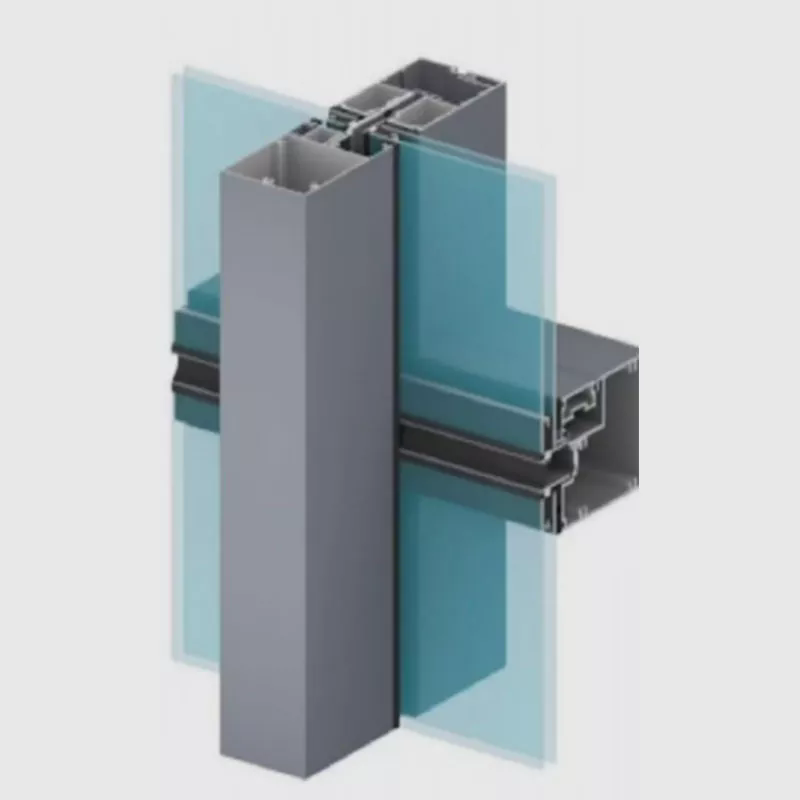The Importance of Curtain Wall Profiles in Modern Architecture
2025-03-04
In the field of modern architecture, curtain walls have become a staple in the design of commercial and residential buildings. These non-structural outer coverings are typically made from glass, metal, or other lightweight materials, and they serve as both aesthetic and functional elements of a building's facade. One of the essential components that contribute to the effectiveness and durability of curtain walls is the curtain wall profile. Curtain wall profiles play a crucial role in shaping the overall performance of a curtain wall system. In this blog, we will delve into what curtain wall profiles are, their functions, and why they are vital in modern building design.
What are Curtain Wall Profiles?
Curtain wall profiles refer to the frames or structural components that form the skeleton of a curtain wall system. These profiles are typically made of aluminum, steel, or other durable materials that are both lightweight and strong. They provide support for the glass panels or other infill materials used in curtain walls. The profiles are designed to withstand environmental forces, such as wind, rain, and temperature fluctuations, while also maintaining the aesthetic appeal of the building.
Curtain wall profiles are typically pre-fabricated and come in a variety of shapes and sizes. They are often customized to suit the specific design requirements of the building. These profiles can be single or double-glazed, and they are often treated with special coatings to enhance their resistance to corrosion and environmental wear.
Functions of Curtain Wall Profiles
1. Structural Support: One of the primary functions of curtain wall profiles is to provide structural support to the curtain wall system. They help distribute the weight of the glass panels and resist wind loads and other environmental pressures. By providing a sturdy framework, curtain wall profiles ensure the stability and integrity of the building facade.
2. Aesthetic Design: Curtain wall profiles also contribute significantly to the aesthetic appearance of a building. These profiles come in various shapes, sizes, and finishes, allowing architects to design facades that complement the overall look of the structure. Whether sleek and minimalistic or ornate and detailed, curtain wall profiles can enhance the visual appeal of a building.
3. Thermal and Acoustic Insulation: In addition to providing structural support, curtain wall profiles play a role in insulating the building. Many curtain wall systems are designed with profiles that incorporate thermal breaks to minimize heat transfer. This helps maintain energy efficiency by reducing the need for heating or cooling inside the building. Moreover, certain profiles can also help reduce noise transmission from the outside, improving the comfort of the building's occupants.
4. Water and Air Resistance: A well-designed curtain wall profile is crucial in preventing water infiltration and air leakage. The profiles are often designed with gaskets, seals, and drainage systems that ensure rainwater does not seep into the building and that the building remains airtight. This helps to improve the overall weatherproofing of the building.
5. Ease of Installation and Maintenance: Curtain wall profiles are designed for efficient installation and long-term maintenance. Pre-fabricated profiles can be easily transported to the construction site and assembled with minimal labor. Moreover, these profiles are often engineered to allow for easy replacement or repair of damaged panels or components without requiring major overhauls to the entire system.
Types of Curtain Wall Profiles
Curtain wall profiles come in a variety of types, each designed to serve specific purposes and suit different building styles. Here are some of the most common types of curtain wall profiles:
1. Stick System Profiles: Stick systems are one of the most common types of curtain wall profiles. They consist of vertical and horizontal profiles that are assembled piece by piece on-site. The glass panels are then installed between these profiles. Stick systems are highly customizable and can be adapted to various building designs.
2. Unitized System Profiles: Unlike stick systems, unitized curtain wall systems are pre-assembled in the factory and then shipped to the construction site as complete units. These systems are quick to install and often offer a higher level of quality control since they are fabricated in a controlled environment.
3. Semi-Unitized System Profiles: This system is a hybrid between the stick system and unitized system. In a semi-unitized curtain wall, the horizontal and vertical profiles are assembled on-site, but the glass panels are pre-installed in the factory. This system offers a balance between efficiency and customization.
4. Spider System Profiles: The spider curtain wall system is often used for glass facades that require minimal visible framing. The profiles in this system are designed to hold the glass panels with the use of spider brackets or point supports. This system is typically used for modern, high-end architectural designs.
5. Double-Skin Facade Profiles: Double-skin facades feature two layers of glass or other materials, providing enhanced insulation and energy efficiency. Curtain wall profiles for double-skin facades are specially designed to accommodate the two layers and ensure proper ventilation between them.
Why Curtain Wall Profiles are Vital in Modern Architecture
1. Energy Efficiency: With the growing focus on sustainability, energy efficiency is a top priority in modern building design. Curtain wall profiles that incorporate thermal breaks and other energy-saving features help minimize heat loss, reduce energy consumption, and contribute to achieving green building standards, such as LEED certification.
2. Design Flexibility: Architects have increasingly turned to curtain walls as a way to create stunning, glass-clad facades that allow natural light to flood the building’s interior. Curtain wall profiles provide the flexibility needed to design these dynamic facades, giving architects the freedom to explore a wide range of design possibilities.
3. Durability and Longevity: Curtain wall profiles are built to withstand the rigors of outdoor exposure. With advancements in materials and finishes, these profiles can resist weathering, corrosion, and fading, ensuring that the building maintains its visual appeal and structural integrity for many years.
4. Safety and Security: Curtain wall profiles are designed to meet strict safety and security standards. The profiles must be capable of withstanding wind loads, seismic forces, and even impacts from external objects. In high-rise buildings or areas prone to extreme weather, these profiles ensure the safety of both the building and its occupants.
Conclusion
Curtain wall profiles are an essential part of modern building design, combining both form and function. These profiles provide structural support, contribute to the aesthetic appeal of the building, and enhance its energy efficiency, insulation, and weather resistance. With various types of curtain wall profiles available, architects and builders can choose the system that best suits their design and performance requirements. As the demand for innovative and sustainable buildings continues to grow, the importance of curtain wall profiles in creating high-quality, energy-efficient, and visually stunning facades will remain a key factor in shaping the future of architecture.



